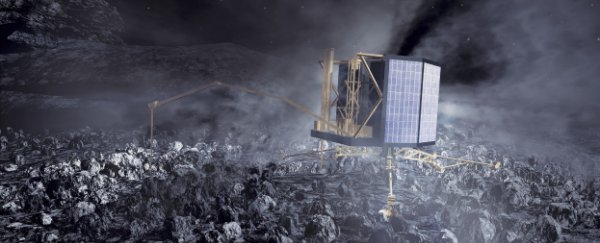For the past 10 years, the European Space Agency (ESA)'s Rosetta spacecraft has been chasing a comet known (awkwardly) as 67P/Churyumov–Gerasimenko. And it's all come down to this - the day has finally come for it to send its lander probe, Philae, down to the surface in an attempt to become the first spacecraft to land on a comet.
In August this year, Rosetta finally caught up with and entered the orbit of the 4-km-wide space rock, which is on its way towards the Sun. Since then we've managed to learn a lot about the nature of comets, such as what they smell like (farts and horse pee) and how they respond as they warm up.
Fascinatingly, just yesterday Rosetta discovered that the comet is producing a mysterious, dolphin-like song produced "in the form of oscillations in the magnetic field in the comet's environment," as ESA's Rosetta blog explains. The frequencies have been increased by a factor of around 10,000 so you can listen to the eerie track below.
But the biggest test comes today, when the ESA attempts to get Philae from the Rosetta craft onto the surface of the comet, a journey that will take around seven hours.
Philae will start its descent from Rosetta at 8pm AEST (9am GMT), and the expected landing time is around 3am AEST (4pm GMT). Because it takes around 30 minutes to up to an hour and a half for Philae to transmit information back to Rosetta, we won't know if the landing has been successful until around 4.30am AEST (5.30pm GMT).
If Philae achieves its goal, it'll stab harpoons into the surface of the comet to hold it into place and use its solar panel to recharge its battery. It'll then start making observations about the comet and beaming them back to Rosetta, until March when the surface will likely become to hot for the lander to survive.
These observations could help us understand how Earth formed in the Solar System, as astrophysicist Stephen Hughes from Queensland University of Technology in Australia explains.
"In some ways, comets are like bricks left on a building site long after the building is completed. We have high hopes the Rosetta mission will allow scientists to 'read' one of these bricks to obtain information about the formation of the Earth," said Hughes in a press release.
In particular, Philae will be analysing the type of water that makes up the comet, and testing whether it's similar to Earth's water. "This may indicate at least some of Earth's water was supplied by comets in the early days of the solar system," said Hughes.
The livestream above (you can also watch it here) has already started and will be continuing throughout the whole process, but you can see the full ESA program here.
Good luck, little lander, we'll all be watching. But, most importantly, good luck to all the amazing scientists, engineers and support staff who have been involved in the mission so far. Let's hope for more of these photos by the end of the day.
Now here's some creepy comet music to keep you occupied while you're watching the ESA researchers nervously await their fate.
Source: European Space Agency, Queensland University of Technology
